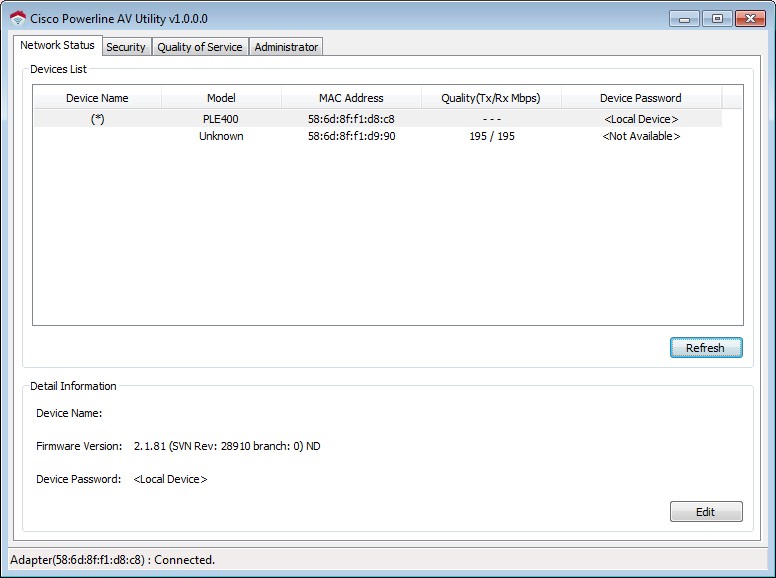
This document is the manual for the Qualcomm Atheros Open Powerline Toolkit. New users should read the first chapter before starting using the toolkit because it will answer many questions about toolkit installation, structure, content and application. C/C programmers can use functions like system or popen in order to call the dLAN® tools from their applications. Besides the dLAN® SDKv3 there is also newly available an Open Source Powerline Toolkit from Qualcomm Atheros, the 'open-plc-utils'. For further information please contact Werner Reis. Atheros Powerline Toolkit Freeware MicroWorld Anti Virus Toolkit v.1.0.6.1 MicroWorld Technologies Inc.has developed a free eScan AntiVirus toolkit utility, that will help you diagonize if your machine is infected by a virus.
Atheros Powerline Toolkit Login

Hardware Version :
Firmware Version :
ISP :
I had a TP Link 4010 powerline which failed to update a firmwareand then apparently bricked on a reboot.
I spent a while trying to find a fix on here and came across the below solution from here.
Looking at the process involved I can imagine it would work on different versions. The only issue I had with the below guide is the need to specify a network interface card adding the switch -i enps20 on the line 'plc/plcboot -N nvm -P pib -i enps20' replacing enps20 with what ever interface is being used, Hope this saves someone time trying to find help So, I just botched a firmware update on one of my PowerLine couplers. The model I had trouble with is a TP-Link TL-PA4020P. However, this quick guide should work with pretty much any Atheros-based PLC device.
Steps to Reproduce
Download manufacturer’s setup tool
[*]Download firmware files (“nvm” and “pib” files)
[*]Refrain from directly connecting the PLC to the computer, instead leave it hooked up to a switch and other hardware.
[*]Start firmware update using the aforementioned setup tool
[*]Have a bit of bad luck
Result
“Firmware Upgrade failed” error message.
[*]Next up, “Local device not connected” error message.
[*]After unplugging and re-plugging the PLC, no lights light up.
[*]Faint hissing from the device, in normal operation it is silent.
Diagnosis
OK, keep calm. This is a modern piece of hardware, surely it wouldn’t need to be disassembled to flash a firmware. Right? Or so my hopes went as I started panicking. Looks like I’m not getting the manufacturer tool to retry the update on the (hopefully just) soft-bricked device. That piece of software only tells me that it can’t find the local device. A quick web search (“TP-Link PowerLine failed firmware fix” and similar) didn’t come up with anything good right away.Well then, I thought, let’s see if it gives off any signs of life. I directly connected the PLC to my trusty MacBook and fired up WireShark. When the first packets started appearing I breathed a sigh of relief. The PLC still manages to get an ethernet link up. Amidst the stuff the Mac fires off when detecting a link (DHCP, MDNS, etc.) I finally found what I was looking for: Broadcast packets, “HomePlug AV” protocol, “Atheros_something” MAC, “Action Required Notification (Bootloader)”. Awesome! This thing is even politely asking me to remote-boot it. Let’s figure out how.
Armed with the right keywords to feed to my preferred search engine, I finally found “Qualcomm Atheros Open Powerline Toolkit” aka “open-plc-utils“. BSD-Licensed tools to set up Atheros-based PLC equipment. And, not really surprisingly, that includes a “plcboot” tool, which does just that – feed the PLC a firmware such that it can proceed to boot.
The Fix
Rename the .nvm and .pib files from the manufacturer firmware package to nvm and pib (The atheros utilities are picky when it comes to file names, something I only found out after head-scratchingly reading the code.)
[*]
git clone https://github.com/qca/open-plc-utils.git cd open-plc-utils make plc/plcboot -N nvm -P pib
[*]Finally, flash the firmware again, using the manufacturer tool. plcboot only performs a one-time boot when given the options above. To make the firmware permanent again, the flash needs to be rewritten. (Allegedly, plcboot can do that too, but it needs a “softloader” file, which I couldn’t be bothered to extract from the TP-Link software.)
Conclusions
I love the fact that chip manufacturers are building in sensible bootloaders, and that there is open source software available to access these. This is for example also the case with the Atmel ARM processor families of Arduino Due fame. I, for one, welcome this trend, making it increasingly hard to turn your hardware into a paperweight. On the downside, OEMs like TP-Link try to hide these as best as they can: the manual just says to return the device to the distributor for service when experiencing the symptoms I’ve encountered.Bottom line: When a firmware update goes bad, don’t panic. It’s just a matter of finding the right tools. Also, it helps a lot having a general grasp of how things work on the inside to actually know what may or may not be possible.
Qualcomm Atheros Open Powerline Toolkit
Older toolkit programs were installed in folder C: Program Files Atheros Toolkit by default but now they are installed in C: Program Files (x86) Qualcomm Atheros Open Powerline Toolkit instead. If you select a different folder during installation then remember it for the next step. Atheros Powerline Toolkit; Download Aprender A Hablar En Publico Vallejo Najera Pdf; Taken 2 Apk Weebly.com; Hunting Unlimited 2010 Download Torent Iso; Oziexplorer 3d 1 11 Serial Killers; Download Lagu Metallica Nothing Else Matters Stafa Band; The Sims Hogwarts Wizarding World Harry.

Comments are closed.